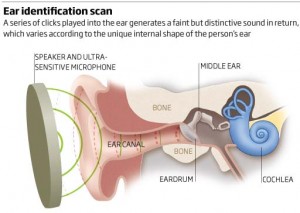Noise from our ears a basis for biometrics

Imagine being on the phone with a call center rep who instead of asking you for the last four digits of your social security number, authenticates your identity through a system that elicits and listens to specific sounds emitted by your ear. If the groundbreaking work of British scientists proves successful, such a biometric technique may become commonplace according to an article published today in New Scientist.
The concept is based on otoacoustic emissions (OAE), which are sounds emitted by the mammalian inner ear in response to an audio stimulation. Their existence was first demonstrated experimentally by David Kemp in 1978, but since, the noises haven't found an application beyond testing for hearing defects.
Thanks to a research grant awarded in 2007, Stephen Beeby, an engineer at the University of Southampton, UK, and his team of investigators have been working to establish OAE as a robust biometric characteristic. According to the New Scientist article, what sparked interest among the researchers was; "The fact that the power and frequency distribution in the OAEs provoked by specific series of clicks seem to be highly distinctive, driven by the internal shape of the person's ear."
According to the researchers, OAEs offer some unique opportunities when applied as a biometric system. For one, it can be embodied as a telephone handset or headphones, which is something everyone is familiar with. And secondly, it can be employed in a challenge-response dialogue: "The stimulus dependent nature of the OAE offers the potential for a challenge-response approach hidden from the subject greatly increasing the performance of the biometric, especially with respect to circumvention."
This means that in addition to revolutionizing the manner in which call centers fight fraud, OAEs can potentially help retrieve stolen cellphones by "rendering them useless by programming them to disable themselves if they detect that the user of the phone is not the legitimate owner" writes the New Scientist.
However, it's a long rode to success and many obstacles exist to establish a new biometric. "In subjects that have been drinking alcohol, for example, emissions are deadened. And different drugs alter the amplitude of OAEs, as do ear infections or wax build-up," states the article.
Beyond these issues, the technqiue would have to demonstrate a low false-match rate and somehow account for the fact that a person's recorded OAE would have to be recognizable over the long-term. And once those hurdles are cleared and the system reaches the market, customers such as those represented by the Financial Services Technology Consortium (FSTC), would throw it down the cost-performance-applications-and customer acceptance gauntlet that's been subjecting existing biometrics to intense scrutiny.
